Y’all, I don’t think I could be any more stoked about A. Andrews recently released comic A Quick and Easy Guide to Sex & Disability. I’m a sex educating cartoonist who likes to do her sex ed through comics. I LOVE COMICS and I think they are an invaluable teaching tool with the ability to speak and show at the same time. For example; this incredible panel which shows two people with cerebral palsy. This panel, in a moment and just a few words, teaches us so much about the range and potential low visibility, or invisibility, of how disabilities present. It teaches us not to make assumptions about anyone’s body, which hopefully you already know. But, you know, reminders never hurt.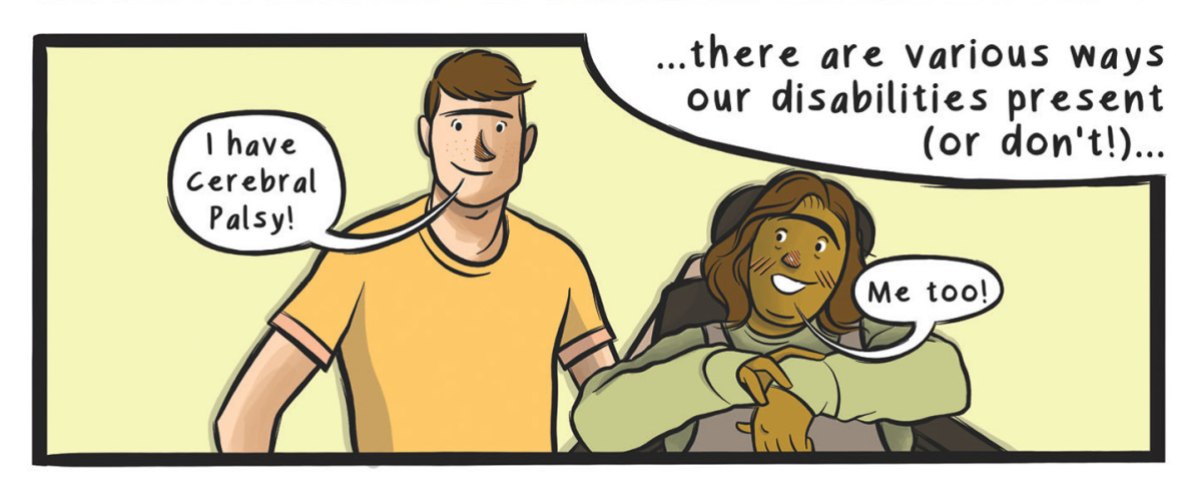
I am also able-bodied, and like most able-bodied people, I do not know as much about disability as I really should. So what could be more of a gift, than this bright and honest comic from my pal and yours A. Andrews, which truly celebrates disabled people and their sex lives?
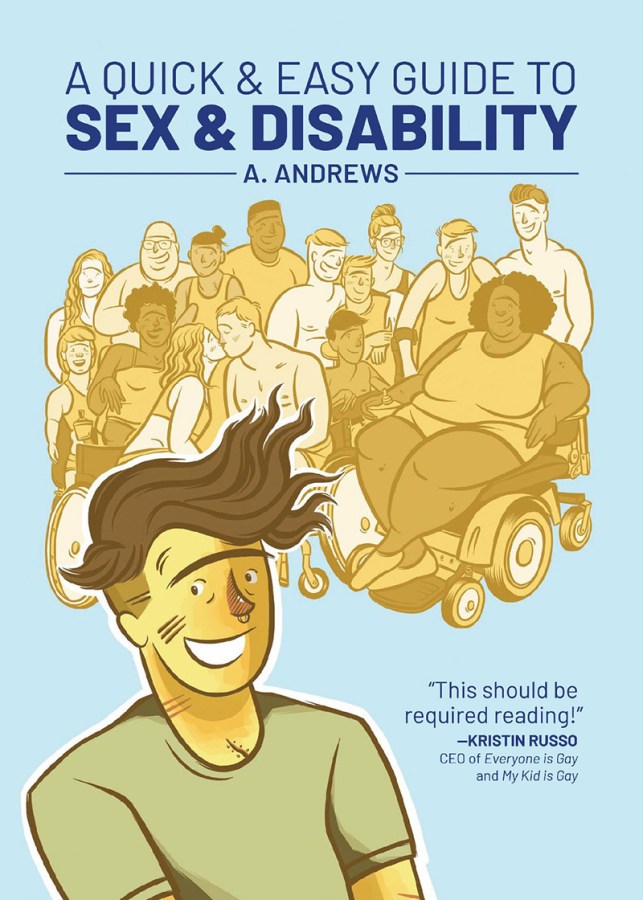
You likely already know A. from their comic Oh, Hey! It’s Alyssa, published right here on Autostraddle from 2016 to 2019. A Quick and Easy Guide to Sex & Disability covers the basics of disability sexuality, common myths about disabled bodies, communication, and practical suggestions for having great sexual experiences. It’s part of the ongoing Quick and Easy Guide series from Limerence Press, a set of quirky and informative comics about sexuality and gender. A Quick and Easy Guide to Sex and Disability is smart, funny, considerate, and well drawn. I learned a lot about the intersection of sexuality and disability, and I had fun doing it. I think you will too.
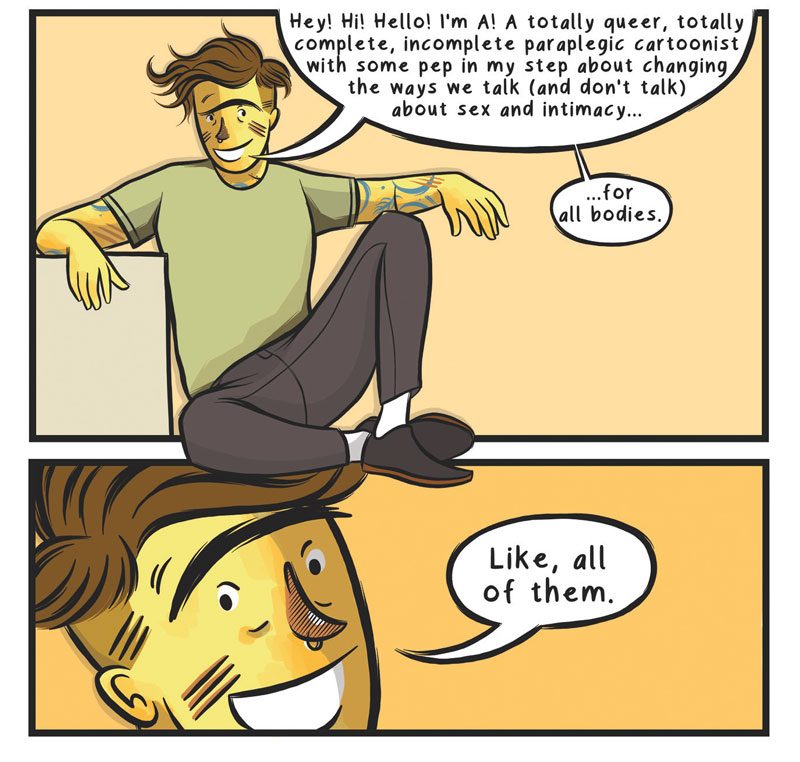
Some able-bodied readers may be tempted to think this book is just for disabled people and their sexual partners; I urge you to reconsider. For me, this book is an opportunity to learn, grow, and make my work as a sex educator more intersectional. It has tips for communication and getting to know your body that are helpful to everyone.
My personal biggest takeaways from a Quick and Easy Guide to Sex and Disability were shockingly simple. Good sex is always about discovering what you like and what makes you most comfortable, communicating that to your partner(s), and adapting joyfully to each others’ wants, needs, and boundaries. The basis of all positive sexual connection is communication and care for both your partner(s) and yourself. A. Andrews knows this. It’s a glowing throughline throughout the entire book that ties just about everything together. This starts with knowing your own body through touch and masturbation. It is always, with another person, about consent. Sometimes it is also about props, waterproof sheets, positioning, sex toys, communicating with health care providers or personal care attendants, and lube. Honestly, if you ask me or A, it should always include lube.
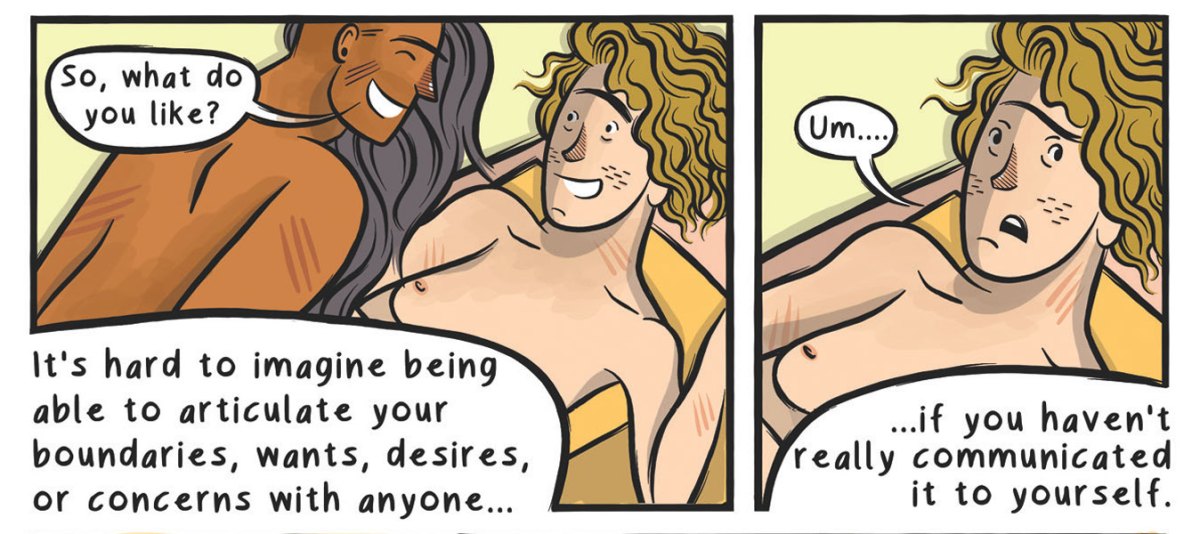
And as if that wasn’t enough of a gift, please enjoy this interview with A. where they answered all my excited sex education and comics questions.
Isabella: What are your hopes for the book in terms of how it might affect how people think about sex and disability? What are you most excited about?
A: I guess I just hope it aids in bringing disability topics into the sex education world and vice versa – like, at all. It’s so unbelievably hard to take the entire umbrella identity of disability and dole out all-inclusive advice for sex and how it all goes down so I think it’d be naive and honestly just wrong of me to make some definitive statement that this is an end-all-be-all resource. Everyone reading this book will be reading it from a different perspective, a different experience (or inexperience) with disability and/or disability sexuality. And while this book is a great starting point, it’s very much what it says it will be: it’s quick and it’s easy. But surely disability sexuality, generally speaking, is neither quick nor easy and there is not a one-size fits all equation to this learning. I’m hoping it opens the door to some of that communication and learning, and that it maybe props it open for good while.
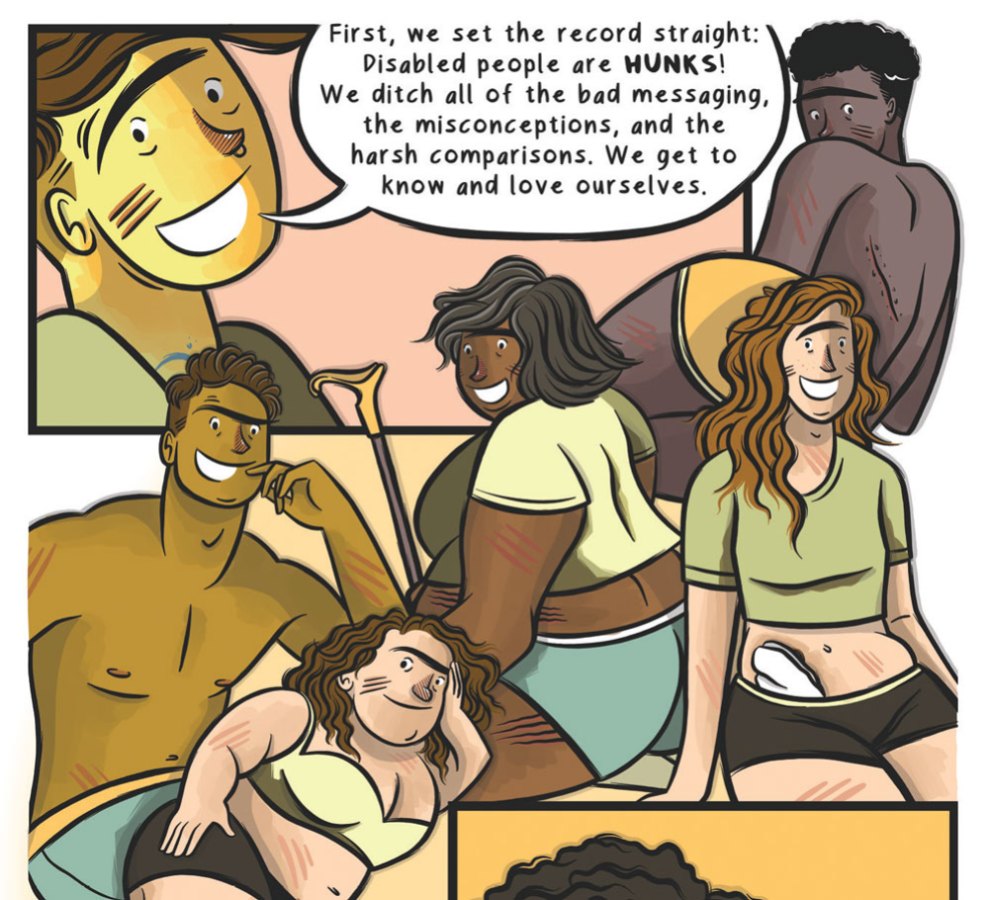
I love the variety of people you drew into this comic. Did you base any of the people off of real people, or are they all entirely fictional? Was anything guiding your choices in regards to how you drew all of the unnamed characters in the book?
A lot of them are at least vaguely based off of real people. I spent a lot of time researching and committing myself to creating representational bodies and body types. I think my number one fear going into it was cartooning a disabled body that isn’t mine! I’ve spent my entire art career observing my own body and lived experience; I felt a real commitment to getting it right. I was really mindful of the need to create a really wide representation of disability, and the greater importance of drawing that in a way that felt inclusive and not voyeuristic or sensationalized.
This is clearly a book that comes from personal experience, but I can also tell that it’s well-researched. What were some of the most useful resources to you during the researching and writing process? What resources would you recommend to others?
The best resources for me will always be the work of disabled activists, advocates, and creators who have been putting this work out into the world and engaging the community directly. Disability twitter is your friend! Books and studies are great and often really informative but the real heart of these conversations will always come from disabled folks directly. There are a lot of great podcasts, blogs, and various media straight out of the disability community that are just incredible. From sex-specific frameworks like Eva Sweeney’s Cripping Up Sex with Eva, to Andrew Gurza’s Disability After Dark, to bloggers like Imani Barbarin and Alice Wong speaking on a number of disability-related topics, and to advocates and writers like Carrie Wade, and Joan Price. All of these people and more are doing this work all the time. Ethical sex shops provide really cool opportunities for learning as well. I’m very much for education rooted first and foremost in the community.
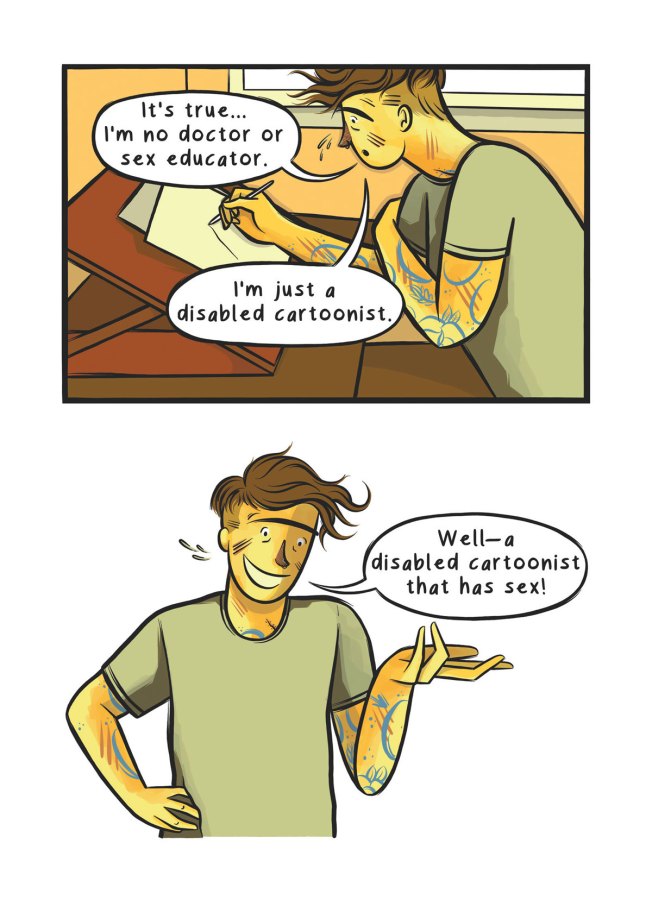
While you’re introducing yourself in the beginning of the book, your character says “It’s true… I’m no doctor or sex educator. I’m just a disabled cartoonist. Well – a disabled cartoonist who has sex!” As a sex educator myself who has struggled with whether or not I am worthy of this professional label, I’m curious about what being or not being a ‘sex educator’ means to you, and why you don’t choose to identify as one even though you are writing a book on the subject of sex education?
Ah! What a question! I guess I just wanted to be mindful that I wasn’t trained in any professional arena to dole out sex advice. My primary viewpoint was just that my qualification* or what have you — the why should you care what I have to say?—piece of this was less about being an authority on it, and more about just being a disabled person here to help you navigate the admittedly-hard-to-navigate. I’d always had so few folks in my life who talked to me about sexuality and my disability identity at all, that I just desperately wanted someone to chat with me rather than ~educate~ me in the patronizing ways I’d personally experienced (Zero shade to sex educators. Sex educators are your friend!) . I think maybe it was just my way of keeping it light and conversational. Maybe it was a bit of cheeky imposter syndrome! I don’t know.
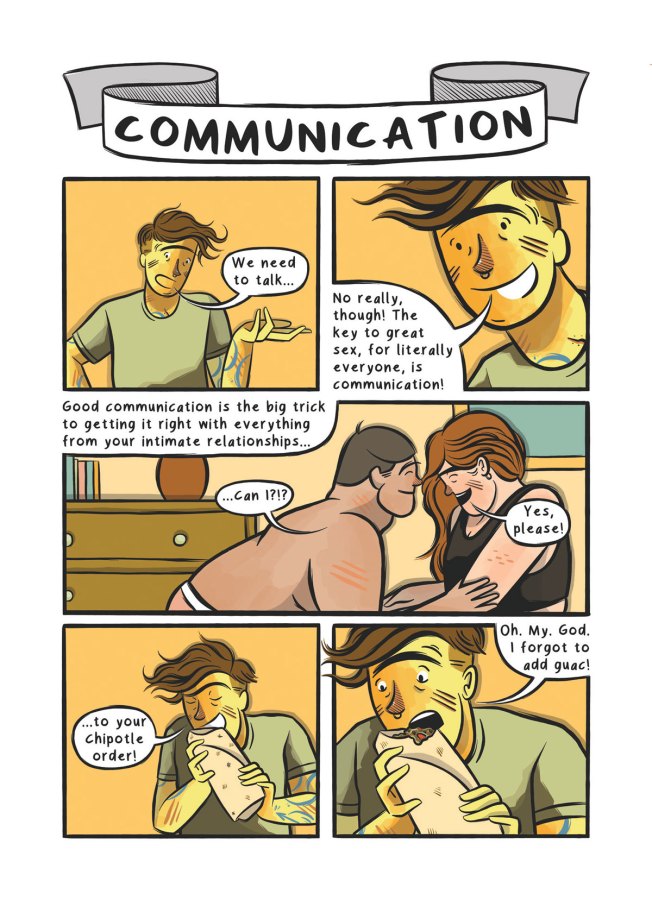
I love your focus on emotional concerns like communication around sex, self-exploration to know what you like, and handling rejection. I feel like this content is of utmost importance in sex education across the board. Would you like to see these ideas more broadly taught, and if so, how?
My god, YES. I wish we all had more education on not only how to talk, but how to listen! Accepting a no is as critical as acquiring a yes when it comes to sex and consent. So much of our communication around sex is clouded in this idea of what sex is supposed to look like or be like—that there’s some general guideline for how it will all play out, and there never ever is! The things that feel good for us and our bodies ebb and flow as often as anything else in our lives. Knowing how to communicate what you want or what you don’t want or what you think* you might* want? That is sex. Positioning tips and toy ideas are cool, but good sex lies in our ability to communicate and feel safe with our partners.
Sex education, and plenty of other education, books, and resources, often leave disabled people out. How would you like to see educators and writers adjusting their writing style and mindset to be more accessible and inclusive?
I think a lot of it lies in body assumption in general. The assumption of genitalia or performative sexual roles, the assumption of sexual identity, the assumption of physical or intellectual ability. There’s a general vibe that sex isn’t for us, when the reality is that leaving disabled people out of sex education access actively harms us. I think if you want to be more accessible you need to center disabled people. It’s not enough to toss disabled folks into sex education that isn’t relevant for us and our bodies. It starts with elevating and listening to disabled people doing the work, and consciously centering access as a priority in the work.
A Quick an Easy Guide to Sex & Disability focuses heavily on physical accessibility needs in regards to sex, but only touches upon the intersection of intellectual disability and sex. Is there a reason you didn’t focus more on intellectual disabilities in this book?
The main reason, I suppose is that I didn’t really feel that that was my story to tell. Disability is experienced in an impossible number of ways for any one person to give voice to. While I don’t consider myself the voice of all people with physical disabilities, that’s most in line with my lived experience and it’s one that I felt confident in navigating in a book like this. The others had more to do with the varying differences in the sex education conversation that just could not possibly fit in a quick and easy comic format. I would love to read more on sex education resources for folks with intellectual disabilities, and to hear more on the topic from more folks who identify as intellectually disabled. I think it’s much needed.
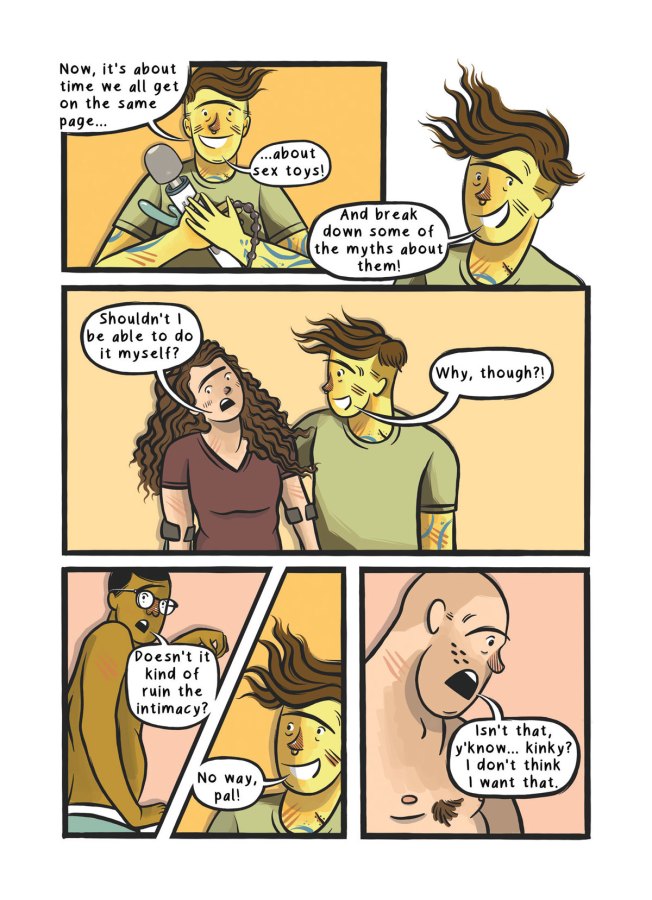
Are there any sex toys or props that you think are particularly good for improving accessibility that you would like to recommend?
It’s a question that comes up a lot but honestly everyone’s needs vary so much, the honest answer is a boring not really. I like the Magic Wand for its versatility. You can mount it, there are lots of attachments, extensions, even a dial to adjust the intensity beyond the toy’s general capabilities — but of course, it’s heavy and bulky so as an end-all-be-all toy? Not quite. The sex item I’d most recommend is a GOOD* lube. Lots of it.
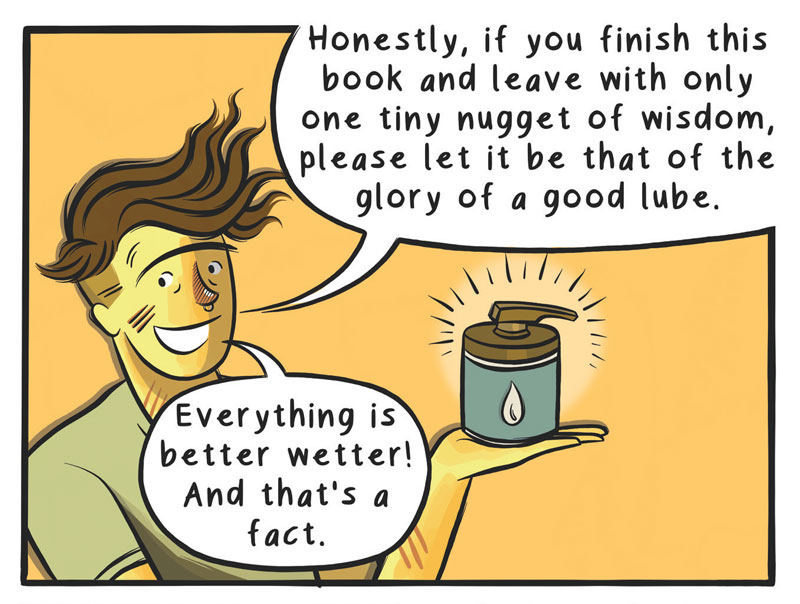
Is there a reason you chose the limited color palette of yellows, earth tones, greens, and teal for this comic?
I wish I had a cool answer! I think I wanted a limited palette to give some uniformity to the book. Outside of my narrative character, there’s a bajillion of them in the book so I think color is one of the pieces that maintains that cohesive element throughout. This was my first long-form cartooning project, so continuity was something I was really conscious of from the start. I think my goal was to get a look that I liked and just keep it up as I went.
If you could choose one, super-duper important take-away that you want every reader to get from your book, what would it be?
Probably just that this is the beginning of a conversation — not the whole conversation! I hope this book resonates, of course, but it’s far from being as expansive as the disability community and the individual sex education needs of any/all disabled folks. I’m one person, and this is one resource. I hope this gives people the confidence and footing to start these conversations and to seek out the expansive work that the rest of the community is doing.
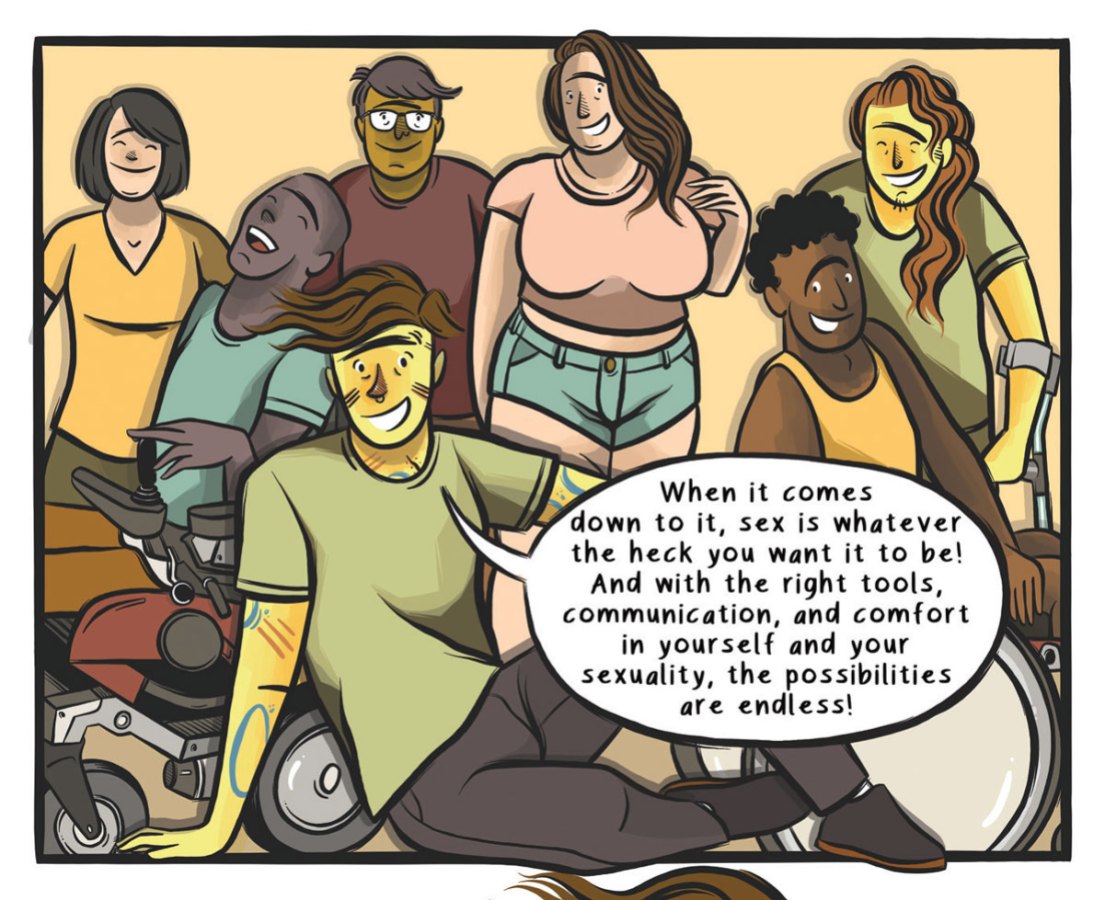
A Quick and Easy Guide to Sex & Disability is the most recent publication from the ongoing Quick and Easy Guide series from Limerence Press, an imprint of Oni Press. All the guides are graphic introductions about a topic in the realm of sexuality and gender. Previous titles include A Quick and Easy Guide to They/Them Pronouns by Archie Bongiovanni and A Quick and Easy Guide to Queer and Trans Identities by Mady G and J.R. Zuckerberg.
You can purchase A Quick and Easy Guide to Sex and Disability from your local local bookstore! I personally recommend Moon Palace Books, Women and Children First, or Semicolon Bookstore and Gallery; it’s also available on Bookshop. If you really want to help A out, consider leaving a positive review on Amazon!



Thank you for this!
this books looks great, looking forward to reading it! congrats to a.!
I’ve always enjoyed A.’s comics here on Autostraddle. Stoked to read this!!
“I’d always had so few folks in my life who talked to me about sexuality & my disability identity at all, that I just desperately wanted someone to chat with me rather than educate me in the patronizing ways I’d personally experienced”
YES THIS!
…except the “it isn’t my story to tell…” narrative has been justified by folks like this author to exclude those of us with developmental/intellectual disabilities (I/DD) from their sexuality/education work for literal decades. And or leave unchallenged our work continuing to be siloed. And or assign the important work of cross-disability collabortion and integration around sex/uality to someone else instead of making their work more inclusive. So imho it’s still a thin af excuse to not have even collaborated with someone(s) with I/DD who is passionate about this work- seriously, there are so many of us out there…including since autistic people like myself are more likely to identify as LGBTQ than neurotypical people, for example- to ensure the comprehensiveness such titles deserve. Until there’s more accountability on this front, color me less than impressed.
Oh, and if the reply from the author is something along the lines of *~but that would have been too hard and inconvenient*~ to that, I say, think of how many times ableds have said that to you. Lateral ableism is a thing, including here.
to clarify, there is no problem with a guide/other resource focusing on physical disability. but imho one can’t focus on (mostly) ANY one aspect of disability only and imply in their title that they meaningfully represented the diverse community.
(tw: filicide) I was disappointed in that reply too. But hey, it’s Autostraddle, so I’m not surprised. They promoted an article defending Issy Stapleton’s attempted murderer, and have still never retracted or apologized for that. If they don’t even support our right to not be murdered by our families, I sure don’t expect them to put effort into providing sex education for us.